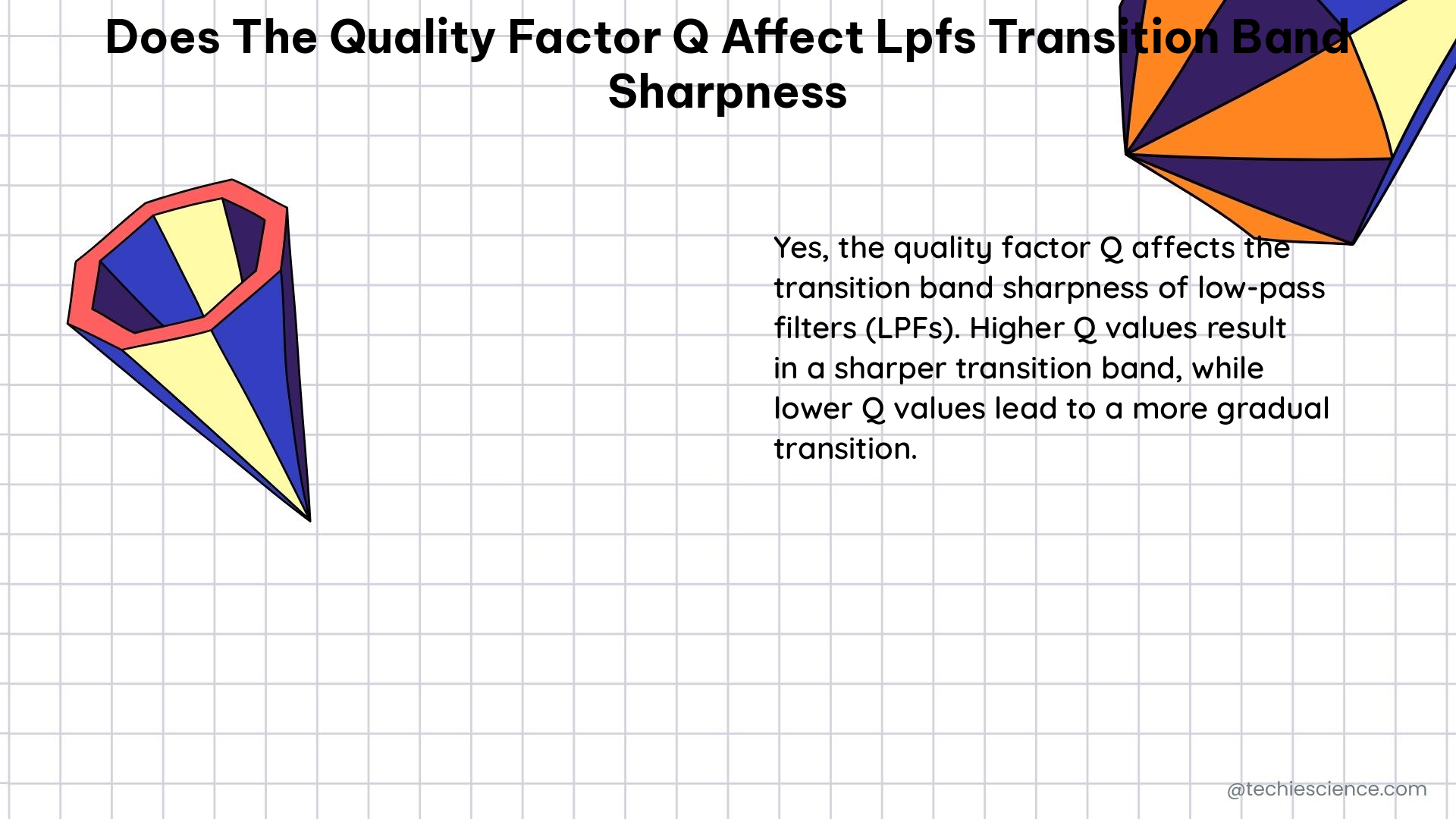The quality factor (Q) of a low-pass filter (LPF) is a crucial parameter that significantly impacts the sharpness of the transition band. The transition band is the frequency range between the passband and the stopband, where the filter transitions from allowing signals to pass to blocking them. A sharper transition band is desirable in many applications, as it allows for better separation between the desired and undesired frequency components.
Understanding the Quality Factor (Q)
The quality factor (Q) of a filter is defined as the ratio of the center frequency to the bandwidth of the filter. In the context of LPFs, a higher Q value indicates a narrower bandwidth and a sharper transition between the passband and the stopband. Conversely, a lower Q value results in a wider bandwidth and a more gradual transition.
The relationship between the quality factor Q and the transition band sharpness can be expressed mathematically as:
Transition Band Sharpness = f_c / BW
Where:
– f_c is the center frequency of the filter
– BW is the bandwidth of the filter
From this equation, it is clear that as the quality factor Q (which is equal to f_c/BW) increases, the transition band sharpness also increases.
Designing LPFs with Desired Transition Band Sharpness

When designing an LPF, the desired transition band sharpness is often a key requirement. To achieve the desired sharpness, the quality factor Q of the filter must be carefully selected and adjusted.
One common approach to designing LPFs with sharp transition bands is to use higher-order filter topologies, such as Butterworth or Chebyshev filters. These filter types inherently have higher quality factors, which result in sharper transition bands.
For example, consider a second-order LPF with the following design parameters:
- Cutoff Frequency (f_c): 3.5 GHz
- Passband Insertion Loss: < 0.3 dB
- Transmission Zero Frequency: 4.1 GHz
- Microstrip Line Width: 1.9 mm
- Characteristic Impedance (Z_0): 50 Ω
- Other Structural Parameters: p = 4 mm, a = 4 mm, b = 8 mm
This filter has a very sharp slope (S) response in the transition domain, thanks to the high-quality factor design. The simulated and measured results show that the passband insertion loss is less than 0.1 dB, and the attenuation level is less than -20 dB within a broad stopband up to 8 GHz.
Adjusting the Quality Factor Q
In addition to using higher-order filter topologies, the quality factor Q can also be adjusted by changing the values of the filter’s components. This is particularly useful in active bandpass filters, where the quality factor Q can be precisely controlled by adjusting the values of the resistors and capacitors in the filter circuit.
The relationship between the quality factor Q and the transition band sharpness can be visualized using a graph of the active bandpass filter quality factor Q as a function of frequency. This graph demonstrates how the transition band sharpness varies with changes in the quality factor Q.
Practical Considerations
When designing LPFs with sharp transition bands, it is important to consider the practical limitations and trade-offs involved. For example, achieving a very high-quality factor Q may come at the cost of increased filter complexity, size, and power consumption. Additionally, the manufacturing tolerances and component variations can affect the actual performance of the filter, which may differ from the theoretical design.
To address these challenges, designers often employ techniques such as tuning, compensation, and optimization to ensure that the final filter design meets the desired specifications, including the transition band sharpness.
Conclusion
In summary, the quality factor Q of a low-pass filter (LPF) plays a crucial role in determining the sharpness of the transition band. A higher Q value results in a sharper transition, while a lower Q value leads to a more gradual transition. By understanding the relationship between Q and transition band sharpness, and by employing appropriate design techniques, engineers can create LPFs with the desired transition band characteristics to meet the requirements of their specific applications.
References:
– Second-order LPFs: (a) Conventional, (b) Proposed second-order LPF structures
– Theoretical and Optimized Dimensions of the LPFs
– Develop a BPF from a Compact DGS LPF
– Filters Using Op-Amps: Band Pass, Band Stop, High Pass, Low Pass Filter
– Relationship between Quality Factor Q and Transition Band Sharpness

The lambdageeks.com Core SME Team is a group of experienced subject matter experts from diverse scientific and technical fields including Physics, Chemistry, Technology,Electronics & Electrical Engineering, Automotive, Mechanical Engineering. Our team collaborates to create high-quality, well-researched articles on a wide range of science and technology topics for the lambdageeks.com website.
All Our Senior SME are having more than 7 Years of experience in the respective fields . They are either Working Industry Professionals or assocaited With different Universities. Refer Our Authors Page to get to know About our Core SMEs.